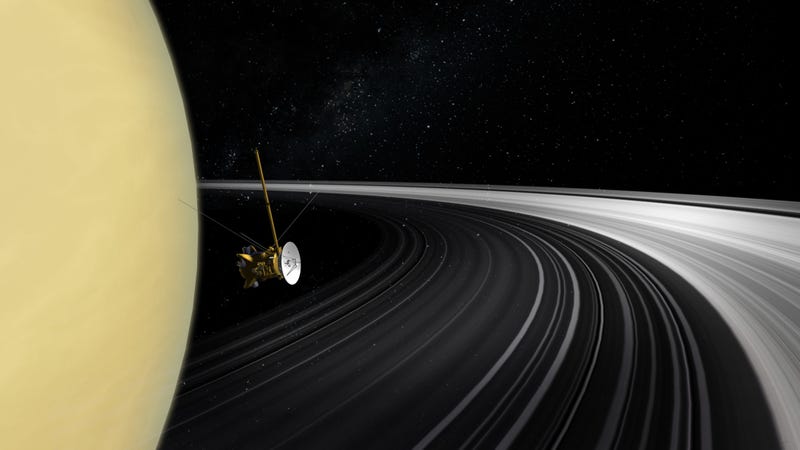
Saturn’s rings might have formed relatively recently—like, in the past hundred million years or so—according to new research.
A team of scientists analyzed Saturn’s gravitational field and the mass of its rings, based on data from the Cassini mission, which ended in 2017. Their measurements led to insights about the planet’s composition and the rings’ young age, at least from an astronomy standpoint.
“Perhaps a big collision formed the rings around the age of the dinosaurs,” Luciano Iess, the study’s lead author from Sapienza Università of Rome in Italy, told Gizmodo. “But for me, the real surprise was the interior structure.”
The scientists assessed Saturn’s gravitational field by measuring a microwave signal that Cassini sent to receivers on Earth during its “Grand Finale orbits.” During these 22 “Grand Finale” orbits, the spacecraft was positioned such that it would graze Saturn’s cloud tops on each pass and send its signals to Earth without being blocked by Saturn. The researchers picked six of these orbits, measuring how the gravitational field around Saturn changed Cassini’s velocity, and in turn, the microwave signal.
After inferring the strength of the gravitational field from the planet and its rings, the researchers were able to pick out the rings’ total mass: around 15 quintillion kilograms. That’s about 7,000 times less massive than Earth’s Moon, or around 0.4 times the mass of the small Saturnian moon Mimas. The team estimated the rings’ age at around 10 million to 100 million years old, compared to the planet’s age of 4.5 billion years. They published their results in Science.
Advertisement
Iess was especially excited by the measurements of the planet itself, which revealed that its gravitational field differed from initial expectations.
“There were people thinking that once we determined the interior of Jupiter, one could know what the interior structure of Saturn was. It turned out to be wrong, because they’re quite different,” he said. It appeared as if the planet’s atmosphere flows and moves around deep into the planet, perhaps 9,000 kilometers (5,600 miles) beneath its cloud tops. But there are still mysterious, unattributable pieces of the planet’s gravity that might be caused by convection, turbulence, or oscillations. They don’t know, said Iess.
This is just one piece of evidence about Saturn’s rings and gravity, of course. “It’s an important piece of the puzzle, but it’s not the only one,” said Kelly Miller, research scientist at Southwest Research Institute who was not involved in the study. She thought that the paper was of intrinsic interest, and noted that more data on rings’ chemical composition could confirm estimates surrounding their age. Iess echoed the sentiment, but noted that this would require sending a probe to sample the rings.
Advertisement
But the young age of the rings has important implications. It means that the feature that we most identify with Saturn might be a new thing, cosmologically, possibly the result of some chaotic collision that occurred millions of year ago, or maybe something stranger. And combined with recent data suggesting that the planet’s rings might be gone in another 100 million years, we’re lucky to live in an age when Saturn has rings, said Iess.
It’s wild to think that Saturn only acquired its iconic rings during the time of the dinosaurs or even more recently. And studies like these could reveal more about how Saturn and its rings formed and how disks in space behave more generally. Now, we’ll just need to send a new probe to Saturn.
https://gizmodo.com/saturns-rings-could-have-formed-during-the-dinosaur-age-1831843646Bagikan Berita Ini
















0 Response to "Saturn's Rings Could Have Formed During the Dinosaur Age, New Analysis Suggests - Gizmodo"
Post a Comment